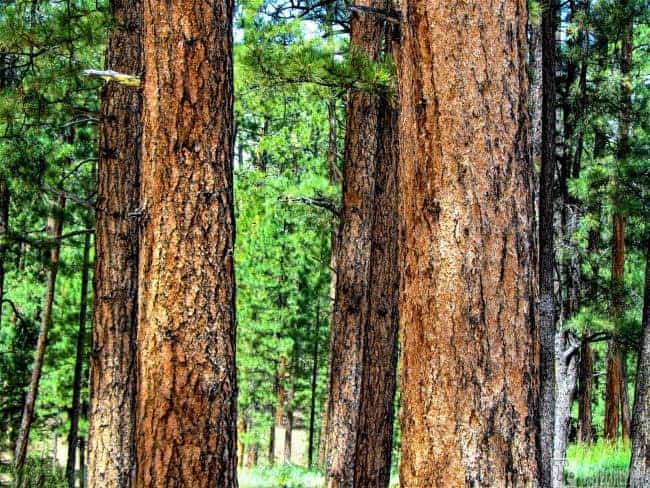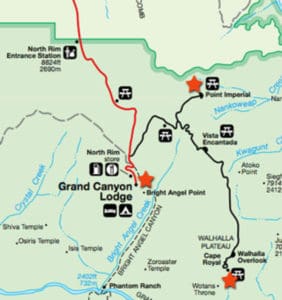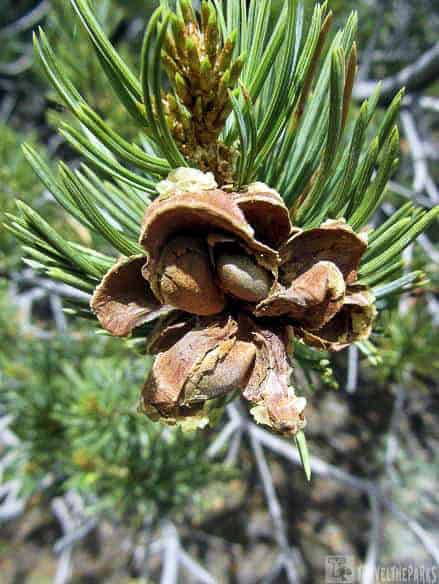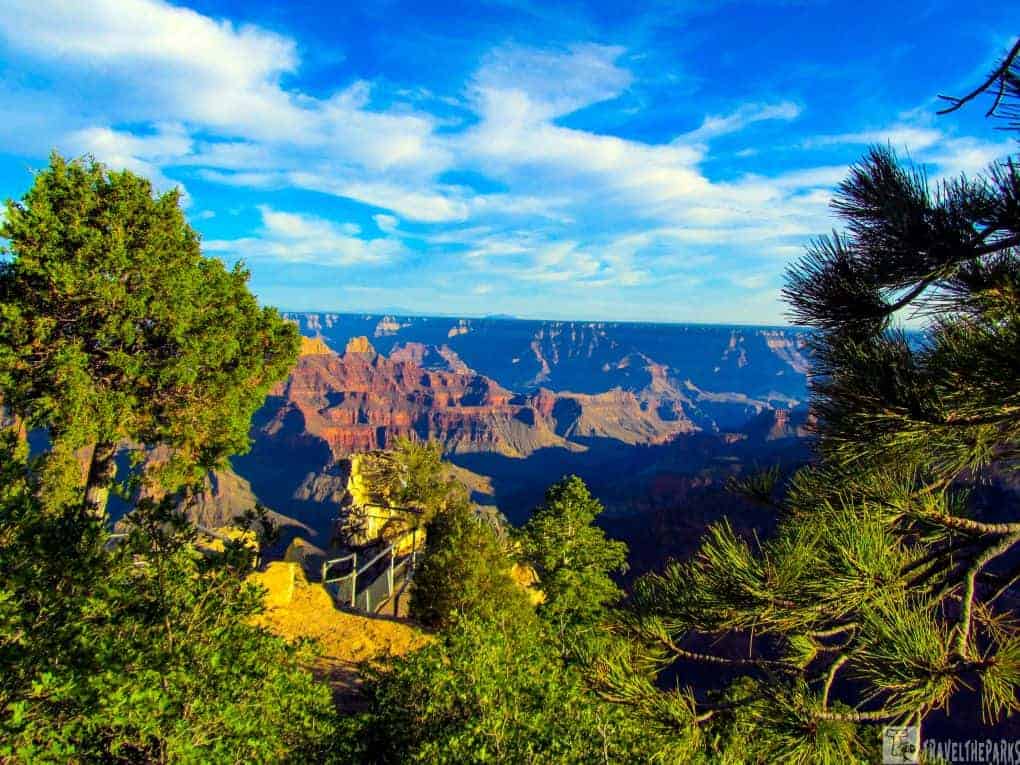Is it worth the effort to explore the North Rim Grand Canyon National Park? How much can I do in 1-day? I would have to say a resounding YES! It was so perfect, hardly overrun with people. The North Rim has 90% less visitation than its southern cousin. You can make your own adventure by setting your own pace to see only what you want to see. I know that writing about it will make it less of a secret, however; we should share it.

The canyon views are spectacular from every vantage point. One tremendous advantage is it has cooler in evenings because of the higher elevation. Though lesser-known, the Grand Canyon’s North Rim is equally stunning as its South Rim counterpart. The North Rim differs completely from the South Rim. The trails don’t seem to have the same crowds, and I personally feel the trails are more diverse. I think partly because of its location on the edge of the Kaibab National Forest; you see lots more wildflowers and wildlife.
This post may contain affiliate links, meaning if you purchase something through one of these links, we may earn a small commission at no extra cost to you! Read the full disclosure policy here.

The North Rim is 1000 feet higher than the South Rim. Therefore, temperatures can be a tad cooler on the North Rim, especially in the mornings. Planning your trip to explore the north rim in advance will leave you prepared for a grand adventure! Families who want to stay inside the park or for whom this trip might be a once-in-a-lifetime event would be wise to plan and book a year or more in advance.
Table of Contents
Explore the Grand Canyon North Rim – What Know before you go

- Seasonal Access: The North Rim is typically open from mid-May to mid-October because of heavy snowfall in winter. Roads and facilities close during winter months, so plan accordingly.
- Operating Hours: The North Rim of the Grand Canyon is open to visitors from May 15 through October 15 each year. Visitor Center Hours: Open daily from 8:00 AM to 6:00 PM during the season. Off-Season: From October 16 through November 30, the North Rim is open for day use only. No lodging or food services are available during this period.
- Entrance Fees: Standard Grand Canyon National Park entrance fee applies ($35 per vehicle, valid for 7 days). America the Beautiful accepted. This pass gains your entry into all the National Parks and Federal Recreational Lands at a cost of $80 per year. Well worth the price!!
- Limited Services: Fewer facilities than the South Rim—lodging, dining, and visitor services are limited and often require advance booking.
- Pets: Leashed Pets: Pets are allowed on the Bridle Trail (Greenway) that connects the campground to the park entrance. Pets are not allowed below the rim, on inner canyon trails, or in park buildings.
- Bring all-weather gear. You really should have walking or hiking shoes as most trails are a combination of loose sand/dirt. Having a quality trekking stick can help on the steeper section of the trail.
- It is advisable to refill your water bottles with cold purified spring water at the taps, either at the North Rim Lodge and the Visitor’s Center, before embarking on any hike. A downloadable map with trail information is always a good idea.
TIP: Remember, this is high altitude and a dry climate, so pace yourself.

North Rim Grand Canyon Travel Guide – Getting There Made Easy
- The North Rim is more remote—expect longer travel times from nearby towns and airports. Best accessed via highways 67 and 89A.Traveling from Bryce Canyon to the North Rim of Grand Canyon National Park takes approximately five hours. Take UT-12 to the intersection US-89, passing Kanab to continue in US-89A to Jacob Lake. Take AZ-67 to the North Rim.
- From Las Vegas, take I-15 N to AZ-389 E and right on US 89A-S, take 89 into Kanab. Kanab is 80 miles from the North Rim of the Canyon. At Jacob Lake, right on AZ-67 S to the end.
- From the South Rim Grand Canyon-take AZ-64 towards Cameron. Left on US-89 N to US-89A N in Bitter Springs. Continue on US-89A N. Drive to AZ-67 S in North Rim.
- The road to the North Rim remains open until it is closed by snow or until December 1st

Exploring Jacob Lake – A Gateway to the North Rim Grand Canyon
Jacob Lake offers a range of convenient services, making it a great stop before heading to the North Rim. Be sure to fuel up, stock up on groceries, and gather any last-minute camping supplies here. If you don’t have a reservation at the North Rim Lodge, you’ll find restaurants, motels, and rental cabins available in Jacob Lake. Outdoor enthusiasts will appreciate the area’s hiking trails, mountain biking paths, and excellent birdwatching. For those looking to stay outside the park, Jacob Lake is a comfortable and scenic alternative.

North Rim Grand Canyon Travel Guide: Stop at Kaibab Plateau Visitor Center First
At the intersection of Highways, US 89A and AZ 67 in Jacob Lake, Arizona. The center is the perfect stop to eat a picnic lunch. Sitting quietly at the picnic area, we watch for the Kaibab squirrels! They only find these squirrels in the North Kaibab region. The squirrel entirely depends on Ponderosa Pines for food and habitat. Their tufted ears and fluffy whitetails make the Abert’s easily identifiable. The first thing you notice at the Kaibab Plateau Visitor Center is the amazing scent of Ponderosa pine in the air. Very nice, high-quality, and reasonably priced gifts are available in the gift shop. Before leaving the Visitor Center to inquire about road conditions and fire conditions that may affect your drive.

The drive from Jacob Lake to the North Rim of the Grand Canyon takes about an hour and is incredibly beautiful. Keep in mind after Jacob Lake, there are limited services available.

Explore the Kaibab National Forest
From Jacob Lake, the road rises dramatically to 9000 feet. This the Kaibab Plateau-North Rim Parkway. The hour drive is through a dense, mixed conifer forest. The forest was lush evergreen until a few miles down the road. Here we could see where the Castle Fire had burned after a lightning strike. Fire plays a vital role in maintaining ecosystem health. Still, it was sad seeing so many trees charred for miles. The landscape had new green growth coming up.

The 1.6 million-acre Kaibab National Forest encompasses part of the largest contiguous ponderosa pine forest in the United States. It extends from both the north and south rims of the Grand Canyon. Elevations range from 5500 to nearly 10500 feet and include a variety of trees, including ponderosa pine, Douglas fir, aspen, blue spruce, oak, pinyon pine, and juniper. The Kaibab, which the Paiute Indians called “the mountain lying down,” changes from life zones of the Sonoran desert zone at one extreme, to the frosty climate of the sub-alpine zone nearer the canyon.

See Little Park Meadows-Bison Herd
Just before you enter the park gate, you round a turn and look over a large, flat valley of grass named Little Park Meadows. It is like looking at the Ponderous (Bonanza) TV show. For miles you see the grass prairie and the herd of bison that wander this valley. The House Rock Bison herd has an estimated population size of 400 to 600 individuals. In the early 1900s, Charles “Buffalo” Jones introduced the herd to the area. Traffic jams happen along the road as cars stop to watch the herd’s movements. Rangers monitor the herd’s activities and move crowds along. Watching the little red dogs play was the highlight of the afternoon.

Exploring the Grand Canyon North Rim
The North Rim boasts breathtaking vistas of the canyon, with a different perspective from the South Rim. The layers of rock are even more colorful here, and the Colorado River appears like a thin ribbon far below.
Scenic Drive Along Cape Royal Road – Must-See Stops on the North Rim
Be sure to take the 23-mile scenic Cape Royal Road drive. The road is a paved two-lane with many switchbacks. You drive through Cottonwood, Ponderosa Pines, and Spruce forests as you make your way to the canyon rim viewpoints. Wildlife is abundant on the north rim.

There is some scarring of the forest visible along the road. This results from a huge, sterilizing forest fire in 2007 and 2009 that killed nearly all the large ponderosa pines. It will be a lifetime before the ponderosa pines regenerate. My advice for each viewpoint is don’t be in a hurry to enjoy the scenery. I would allow about 45 minutes to drive to Cape Royal at the end of the road. The vistas include Walhalla Overlook-Cape Royal, Roosevelt Point, Vista Encantada, and Point Imperial Point.

Picturesque Point Imperial

About 5-miles in, you’ll come to a Y-intersection. To the left is the Point Imperial Drive to Point Imperial, the park’s highest overlook at 8803 feet. You need to bear right and drive 3-miles uphill to reach the point. There is ample parking, clean pit toilets, and picnic tables. Point Imperial is a 0.1-mile short trail to an overlook that has guard rails. There are vast, expansive views of the canyon. A walk along the trail provides a broad panorama of the northeast side of the Grand Canyon and the cliffs and plateaus beyond. Far to the east are Navajo Mt. and Lake Powell, while to the north are the Vermilion Cliffs and the Grand Staircase-Escalante in Utah. We saw a dead rattlesnake run over in the road. On the switchbacks, I could see how the driver could not avoid hitting it. I still felt bad for the snake.

Vista Encantada Viewpoint
There is a small pullout on the right towards Roosevelt Point on Cape Royal Road. This is a suitable spot to stop and have a picnic lunch. There are picnic tables where you can sit and enjoy the enchanting views of fir trees on the canyon rim. If you plan to hike, be sure to have a refillable water bottle to quench your thirst in the heat. In the summer, the hot dry air can take its toll if you don’t hydrate. The overlook at Vista Encantada provides views of the Walhalla Plateau.

Historic Roosevelt Point
The next pullout on the road is on the left. Roosevelt Point Trail is a 0.3-mile loop trail at an elevation of 8470 ft. Looking east offers a look at the confluence of the Colorado and Little Colorado rivers. It’s an easy and relaxing walk. The wildflowers are beautiful that line the path to the rim. Roosevelt Point, named at the President, delivered the quote below:



Walhalla Overlook See the River
The overlook is at a low elevation on the North Rim and provides a superb view of the Unkar Delta. At Walhalla Overlook there is a paved pull-out on the east side of the road for parking. There is an unpaved path that leads to recent excavations unearthed from ancient dwellings known as Walhalla Glades Pueblo. They inhabited this area from 1050 to 1150.

Across the road is the trailhead for the Cliff Springs Trail. It is a short 1.1-mile downhill hike through a small ravine that passes an ancient Puebloan granary. The trail is boulder-strewn, but the hidden spring that emerges from the small alcove is sweet! The spring water provides a source of water for wildlife and mosses. Because it is not well marked, it is difficult to see where the actual trail ends. You can continue further, but we turned around after seeing the spring. I love hikes too little hidden surprises like this one!

Cape Royal & Look through the Angels Window
Cape Royal is the southernmost viewpoint on the North Rim of Grand Canyon National Park. At the end of the road, park in the gravel lot and walk the 0.6-mile round-trip trail. It has the most spectacular panorama of any overlook in the Grand Canyon. Among many peaks are Freya Castle, Vishnu Temple, and Wotans Throne. The Colorado River and Unkar Delta are visible if you look to the east.

Nature humbles people! Words are inadequate to describe how humbling of an experience it is to stand on the rim of the Canyon and look out over what took countless centuries to create. The Colorado River carved this canyon. The average depth is 4000 feet for most of its 277 miles. It is 6000 feet deep at its deepest point and 15 miles at its widest. Make sure you take the side trail to Angels Window, a natural arch which frames a little section of the Colorado River, 5000 feet below, and 6-miles distance.

Hike to Bright Angel Point
The trail begins at the Visitor Center parking area. This is an easy half-mile walk round trip from the lodge. There is a steep 200′ elevation change, ultimately ending at an elevation of 8161 ft. However, that being said, if you are afraid of heights, this may not be an easy walk for you. Just writing this makes my hands sweat. If you have trouble with heights, you’re going to have a problem. It was quite windy when we made this trek. At one point the trail is narrow, with drop-offs at both sides. I made it out to the point by clinging to the rocks, not looking at the sheer drop-offs on either side. But the view at the end is worth it.

To the west, Bright Angel Point looks over the end of The Transept, with Oza Butte rising above and Manu Temple just beyond. To the south is the expanse of Bright Angel Canyon and the jagged ridge bordering it, on top of which are three prominent peaks named after Hindu deities—Deva Temple, Brahma Temple, and Zoroaster Temple. The dead flat Walhalla Plateau occupies most of the eastern view. I’m sure that if it had not been so windy, we would have heard Roaring Springs 3100 feet below the rim. On your way back, if you take the left fork, you walk below the lodge. Marvelous views from this vantage point for those that do not want to brave the trail to the point.

North Rim Visitor Center
The visitor’s center is open from 8 am to 6 pm daily. (May 15 through October 15). Visitors can find park maps and other information at the Ranger desk. There was an amazing selection of merchandise in the gift store. Pickup a schedule of Ranger-guided tours and activities. I found the interactive displays to be informative, however; I love to learn the geology of the parks. Public restrooms are in the back of the building.

Canyon Mule Tour
Consider booking a Mule ride, either the 1-hour rim or the three hour Supai tunnel. Most of the one-hour ride was on a forested trail away from the rim. Not that many canyon views. On the 3-hour ride into the canyon, the trails are narrow, however; you get panoramic views of the canyon. You stop and dismount at the halfway turnaround point: Supai Tunnel, where there are freshwater fountains and restrooms. Mule rides into the canyon are less crowded and less expensive than the south rim. Great way to see the canyon and save your lungs on the hike out of the canyon.

Explore the Grand Canyon North Rim – Prospects to Consider Staying in the Park
We stayed here for one night in the hotel. The rooms feature one queen-sized bed, a small refrigerator, and a private bathroom. We originally booked a cabin, however, a blip in our schedule to change our original booking. Some cabins have canyon views, however, the hotel does not. Parking for the hotel is across the street.

The North Rim was very crowded with numerous tour buses, but later in the evening becomes silent. The veranda of the lodge is a wonderful place to have an adult beverage in Adirondack chairs sitting right next to the Rim to breathe in the beauty. While visiting the Lodge, make sure you rub the statue of Brighty’s nose, the little burro made infamous by Marguerite Henry’s book “Brighty of the Grand Canyon”.

Grand Canyon Lodge
There is no alternative to staying in the Lodge if you are planning to explore the North Rim Grand Canyon National Park. Perched on the cliff overlooking Bright Angel Point, the lodge is a National Historic Landmark. They constructed the lodge in 1927-28 designed by architect Gilbert Stanley Underwood. The main building and a few cabins burned to the ground in 1932 and rebuilt in 1937. Constructed of native stone and timber, they design the complex to blend with the rocky woodland setting. They designed it to create a specific sense of place that makes the lodge a unique and striking destination at the Grand Canyon. It’s a gorgeous building. I loved the indoor and outdoor seating that allows visitors to relax and savor the lodge’s 180◦ panoramic views.

Between October 15 and October 31, the Grand Canyon Lodge and restaurants are closed, but the North Rim Campground remains open with limited services. Between November 1st and December 1st, the North Rim is open for “dawn to dusk” day use with limited services.

Staying in the North Rim Campground
The first thing you notice is the fresh smell of the Ponderosa Pines. The campground is ideally located to the rim with access to several trails. They spread the campsites throughout trees and being at the edge gave a feeling of privacy. The canyon rim is only a short walk to watch the sunset or sunrise. Search for sites well ahead of your visit. They require reservations months in advance by calling 1-877-444-6777 or online recreation.gov.
The campground has a well-stocked general store with everything you could need, including your coffee, fresh fruit, and vegetables, camping supplies, Wi-Fi, an ATM… literally everything. The coin-operated showers and laundry facility are well – maintained. We stopped at the general store to use the Wi-Fi.

Grand Canyon North Rim Proposed Dining Options
If you stay at the Grand Canyon Lodge, unless you go to the onsite deli or bring your own food, you must eat at the Lodge’s restaurant. There are no other restaurants within 45-miles and for this reason, they advised us when we booked our accommodation at the Lodge to go online a few months ahead of your visit to book dinner reservations.

The Grand Canyon Cookout Experience
This is a “chuck-wagon dinner.” You take a tram to the campground. They set a large tent with tables up behind the gas station. The buffet-style menu includes barbequed chicken and beef brisket, potatoes and sweet potatoes, corn on the cob, beans, veggie stew, biscuits, salad, fruit cobbler, and fresh cookies. The entertainers are extremely talented and their songs relate to the history of the North Rim. The cookout is open from June 1st to October 1st.

Grab and Go – Deli in the Pines
We had a quick bite to eat in the evening before we arrived. The Deli in the Pines gives you the convenience of grab-an-go. They offer a great selection of sandwiches, premade and fresh salads, pizza, elk chili – all kinds of stuff. They also have soft-serve ice-cream, a wonderful selection of chips, energy bars, cookies, fresh fruit, etc. Great for hikers on the trail. They also make great pizza. You can order a whole one just how you like it, or buy a slice off the rack. We grabbed a few slices and headed for the outside veranda to enjoy the sunset.

Grab a Coffee or Drink – Rough Rider Saloon
This is a great place to have a drink at the Grand Canyon Lodge, North Rim. Decorated in the “Old West” Teddy Roosevelt style, they offer a full bar, local craft brews on tap, and a prickly pear margarita. Get a to-go cup and drink your beer on the balcony overlooking the Canyon. The Saloon was a great place for breakfast: burritos, pastries, muffins, and bagels. There is also an excellent selection of coffees, lattes, and cappuccinos.

Grand Canyon Lodge Dining Room – Best Views Ever!!
We ate breakfast in the Grand Canyon Lodge Dining Room. No reservations needed for breakfast first-come, first-served. We decided not to have the buffet, very expensive compared to Zion & other parks. We opted to have a simple egg breakfast from a la carte menu. There can be no question that the restaurant’s location is superb. Watching the sunrise showcases the beautiful colors of the canyon’s rock walls.
NOTE: The buffet is utilized by patrons of the bus tours so it gets busy super fast (smaller buffet too).

The breakfast opens at 6:30 am a little later than other parks. I suggest getting in line before that time to get a good seat by the windows. The atmosphere makes eating here worth doing at least once during your stay. It would disappoint to miss the spectacular sunrise views.

Final Thoughts on How to Explore the North Rim Grand Canyon in 1 Day
With only one day at the North Rim Grand Canyon, you’ll want to maximize your experience. This needs to be added to everyone’s southwest bucket list itinerary. Remember, this itinerary is just a suggestion. You can tailor it to your interests and preferences. With careful planning and these tips, you can have an unforgettable exploration of the North Rim Grand Canyon in a single day.
Have you visited the North Rim? What did you think? Please let us know in the comments below!




